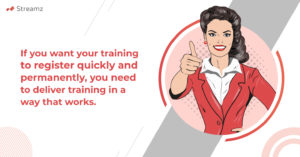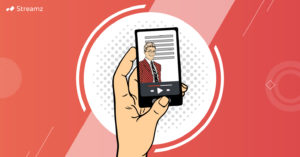Nandakumar Chari
SEPTEMBER 28, 2020

According to a report by Microsoft Canada, the average human adult’s attention span is just 8 seconds.
To give you a perspective, the incredibly short-focused goldfish is said to have an average attention span of 9 seconds, so it might be better off than us!
Diminishing attention spans might well be attributed to the effects of increasingly digitized lifestyles on the human brain. Also, the fact that most of us multi-task, or rather multi-screen, we aren’t just working on one thing at a given time, further resulting in divided attention.
Unfortunately, the need to deliver great training hasn’t dropped in line with dropping human attention spans. If anything, today’s rapidly changing economic and social landscape makes sustained training crucial to the success of any organization.
The fact is that the human brain is just not wired to retain focus for hours on end, especially if it perceives something repetitive and boring…something that’s often associated with training.
So, it’s a huge challenge to get easily bored and distracted people (look, a flying saucer!) to pay attention to what they’re learning.
Training and the sales function
Since sales lead the change to achieve business targets and goals, the sales function is almost always under an organization’s microscope, and expectations from sales personnel are sky-high. This makes training and upskilling a key part of sales enablement.
Can the sales force be trained using the same methodologies applicable to say, college students? Probably not!
You cannot tie sales executives to their desks specifically to complete the e-learning programs they’ve been assigned. They’ll mostly be in the field, traveling extensively, meeting clients, and not to forget, scurrying to meet all kinds of proposal deadlines. Such people thrive on multitasking and need to grasp information fast and send out replies even faster.
Their roles call for mastery of some complex behavioral and business skills – which makes effective training the key. Having said that, they do not have the time to get involved in long, detailed courses, which tend to have a lot of introductory fluff before coming to the point. What they need is direct, to-the-point, absolutely relevant, and immediately useful information.
Thanks to mobile technology, the way our brains consume information has changed. We can now access content on-demand, in small spurts. And we aren’t too happy if that doesn’t happen.

Moral of the story: If you want your training to register quickly and permanently, you need to deliver training in a way that works.
Say hello to microlearning or bite-sized learning! To get attention, you need to give it due attention.
What is microlearning?
Microlearning, also known as bite-sized learning, is the practice of delivering training in small, focused chunks that are easily digestible and do not require learners to commit extended amounts of time.
If we were to use educational technology jargon, we would say that microlearning is any targeted learning objective or brief that spans anywhere between 3 to 6 minutes. Sometimes, training even as short as 90 seconds is considered microlearning. But it’s important to note that brevity isn’t a silver bullet. Content must also be clear and super-focused for microlearning to be effective.
Microlearning works something like this – instead of delivering a 30-minute training session that covers a topic in-depth, it is broken up or “chunked” into 5 or 6 short modules, each focusing on a single aspect of the topic. Ideally, there should be just one learning objective for a module.
Microlearning is the need of the hour, more so because of the way modern learners function in their day-to-day lives. According to a study, the average employee works uninterrupted for just about 11 minutes before he’s disturbed by either an urgent email popping up, a phone ringing, or a co-worker stopping by.
It’s important to note that though most people understand microlearning as learning on the mobile, honestly it can be done on any medium – through streams on your desktop, Alexa, etc. People have short attention spans in general, whether they’re browsing on a large screen or a small one, whether it’s social media, Whatsapp, or anything else.
Why do bite-size learning and chunking work?
The need for ongoing training of almost-always-busy personnel in the sales arena makes microlearning a better option as compared to traditional e-learning methods.
Chunking of information significantly contributes to improving the e-learning environment.
Here’s why:
1. “Just-in-time” knowledge

Sales professionals can quickly benefit from training that’s easily accessible through always-with-them mobile devices – and available in handy, bite-sized chunks – just when they need it. When you deliver contextual learning, it enhances learning retention, at the same time providing a considerably higher degree of relevance and value.
2. Employee-specific learning

Different employees approach their learning differently – with their own unique blend of interests, experiences, and competencies. Training is hardly ever a one-size-fits-all model. With on-demand, bite-sized learning available, employees can personalize their learning according to their individual requirements. They can assimilate content quickly, or sometimes delve deeper — always progressing at their own pace — something that’s key for employees with busy schedules.
For example, at Streamz, we offer bite-sized learning to the retail staff when new products are launched or new promotion campaigns are set off. Since the teaching module focuses on short chunks, we can easily assess the staff’s understanding and re-train them quickly if necessary.
3. More economical pieces of training

While acknowledging that training is necessary, businesses often find it expensive to keep revenue-generating staff away from where they need to be. Training sessions can sometimes span across days or even weeks. Enabling employees to access bite-sized learning whenever they have short spurts of downtime keeps them where they’re needed. Importantly, the time and costs related to developing course material broken down into bite-sized chunks are substantially lower as compared to traditional full-length courses.
4. Employees stay current

Since microlearning offers highly accessible course materials that are relatively inexpensive to develop, employees can get better trained while staying tuned to the latest trends within their industry, as well as keep up with technological advancements. New course material can be developed more rapidly and training can evolve in line with the pace of marketplace changes.
5. Anytime, Anywhere Learning

Microlearning is a tailor-made approach for most learners since training is presented in small, easily digestible chunks, it’s available when needed, and can be accessed on-the-go. It focuses on few, specific learning takeaways and works perfectly for audiences with short attention spans. Because modules can be completed in a short while and can be accessed from any device, anywhere – microlearning suits varied learning needs.
A major advantage of microlearning is that it can help in swiftly reinforcing concepts. Since training modules are short, any time learners need to refresh some knowledge, they can quickly retake a lesson and voila! The job is done.
6. More engagement, better retention

Microlearning course designs can include rich media formats that engage learners and result in better retention of knowledge. Learners can take their training at their own pace, wherever they feel comfortable, and most importantly when they feel they are mentally “ready.” Because bite-sized modules are more focused, learners are not served irrelevant details likely to clutter their memories. Factual, to-the-point information makes retention easier.
The finest solutions
It’s not as if a short learning session guarantees completion without interruptions. This is a challenge that instructional designers have to face while creating content. Assuming distractions are the norm, our microlearning platforms offer enablers like play-pause features, the ability to resume training from where a learner left off, and more.
When it comes to taking training on a mobile phone, there’s every possibility of small-screen fatigue setting in because there’s only so much you can view on a small screen at a given time. There’s often a lot of scrolling up and down, left and right. This is where flash-cards come in.
When the content is split into a sequence of cards (streams) and arranged in logical sections, the entire stream and its components can be super-tagged. This enables delivering the right information leading to the right outcome, whether it’s for reference or actual learning. Imagine a scenario in which you need to recall or reference a particular product specification – would you prefer a PDF to go through or laser-sharp delivery of only the needed information – no less and no more?
Last words
If your organization is looking for quick gains from your sales training programs, it’s worthwhile to consider microlearning as a crucial delivery mechanism.
For businesses, microlearning offers faster development, easier deployment, as well as quicker and better results. For employees, microlearning courses translate into engaging opportunities to upskill, improve performances, and instantly transfer concepts learned to their jobs. Small training modules allow employees to conveniently refresh and reinforce concepts.
Thus, deploying microlearning practices can prove to be a highly beneficial experience.
We at Streamz have made it our mission to help you easily create micro-learning content in minutes on an AI-enabled platform that does the hard work for you. Connect with us to help us help you!







